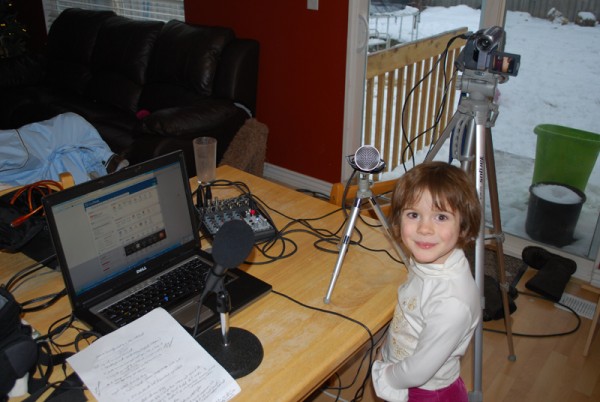Trying Out Picture in Picture in Screencasts
In a previous post, Adding the Human Element in Screencasts, I argued that adding a human element in a screencast (by human element, I mean someone you can actually see talking) increases the appeal of the video significantly. So I tested this out by adding a picture-in-picture (PIP) effect for two WordPress screencasts.
(By the way, the WordPress screencasts I create are mainly to test out some screencasting methods. But I hope they're also useful to the WordPress community -- I usually push them out to WordPress.tv.)
Here's my first attempt to incorporate a human element. I just came back from playing basketball, and it's late and dark, and there's a bunch of junk in the background. I was going for the "real" effect here. But I made a fatal mistake. I plugged my mixer directly into my ancient Sony camcorder, and I think the camcorder's default audio setting is on auto-gain, so when I'm not speaking, it increases the background static like a rushing wind.
I made another mistake: I thought I could use one microphone and just kind of discretely hold it, so that it was close to my mouth when talking into the camera or the computer screen. But when I'm holding that mic in my hands, every little hand movement transfers into the microphone, and it sounds like I'm stretching a balloon at times. It's also just awkward to hold it.
Overall, the audio in this video is poor. The video is mostly uninteresting, and the screen demo is a little slow. But hey, this was my first PIP attempt.
With my second attempt I corrected a few things. First, I plugged two mics into my mixer and then the computer, not the camcorder. I stopped handling the mic during the recording and just attached them on little stands. As a result, the audio sounds a lot better.

I also recorded in a place where natural light abounds -- my dining room, next to the giant patio glass door. There was just one fatal flaw in this setup: it was a Saturday afternoon and my three kids and wife were at home. In case you didn't know, kids are drawn to microphones and video cameras like cats to string, and it was a little nerve-racking. Additionally, Shannon says the kitchen is her office, and she doesn't have to be quiet in her office.
By the way, Shannon makes a cameo appearance in this video! Yep, pretty cool. Watch for it, though. It's subtle. Look for her disapproving countenance as she passes.
Although the lighting was good, that's the last time I will be recording anything in our dining room area. See Jane's post for more details. :)
This video starts off with more explanation than I intended. The file size ended up being huge -- 233 MB when produced through Camtasia into MP4 format. I opened the MP4 in Quicktime Pro and saved it for the web in a MOV format, which reduced it, surprisingly, to 50 MB. I then uploaded it to Youtube, but Youtube didn't convert it to HD like it did the other one.
I'm not sure why it didn't convert the video to HD. Perhaps Quicktime encodes the video with a codec that isn't compatible with Youtube's codec? I'm not sure, so I uploaded the 233MB monster MP4 video file and it did convert it to HD.
So what do you think? Does adding the human element increase the appeal, even as ordinary as I am?
One advantage with including a talking head, I realized, is that it fills the gaps when you explain concepts in videos (when you explain concepts, you usually don't move your mouse and the screen is still). Without the talking head, you would normally resort to diagrams, charts, and workflows to provide eye candy during these static moments. But with the talking head, you can just talk to the user and still keep him or her watching.
I think I'll invest in a couple of studio lights for my office to give it better light. I told my manager that I might need to add a studio light in a conference room the next time I record video tutorials for work, and he asked if I would also be wearing makeup to compensate for strong light that might wash out my face. Uh, no. Wearing makeup before heading off to a conference room ... will be the last thing I ever do. In that case, he said I should try to bounce the light.
There's so much to learn with video, I suppose.
About Tom Johnson

I'm an API technical writer based in the Seattle area. On this blog, I write about topics related to technical writing and communication — such as software documentation, API documentation, AI, information architecture, content strategy, writing processes, plain language, tech comm careers, and more. Check out my API documentation course if you're looking for more info about documenting APIs. Or see my posts on AI and AI course section for more on the latest in AI and tech comm.
If you're a technical writer and want to keep on top of the latest trends in the tech comm, be sure to subscribe to email updates below. You can also learn more about me or contact me. Finally, note that the opinions I express on my blog are my own points of view, not that of my employer.

